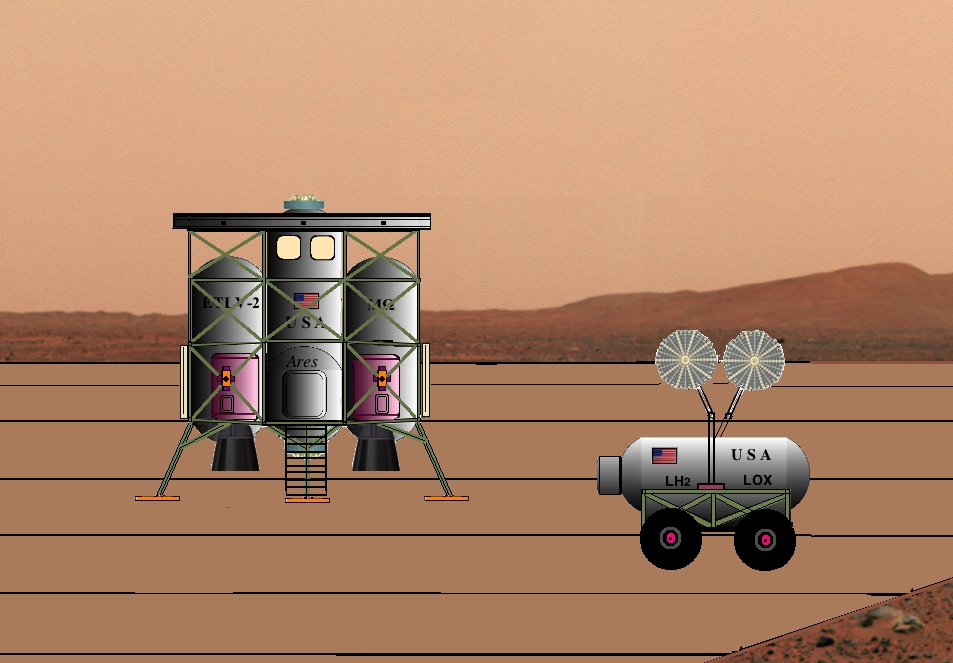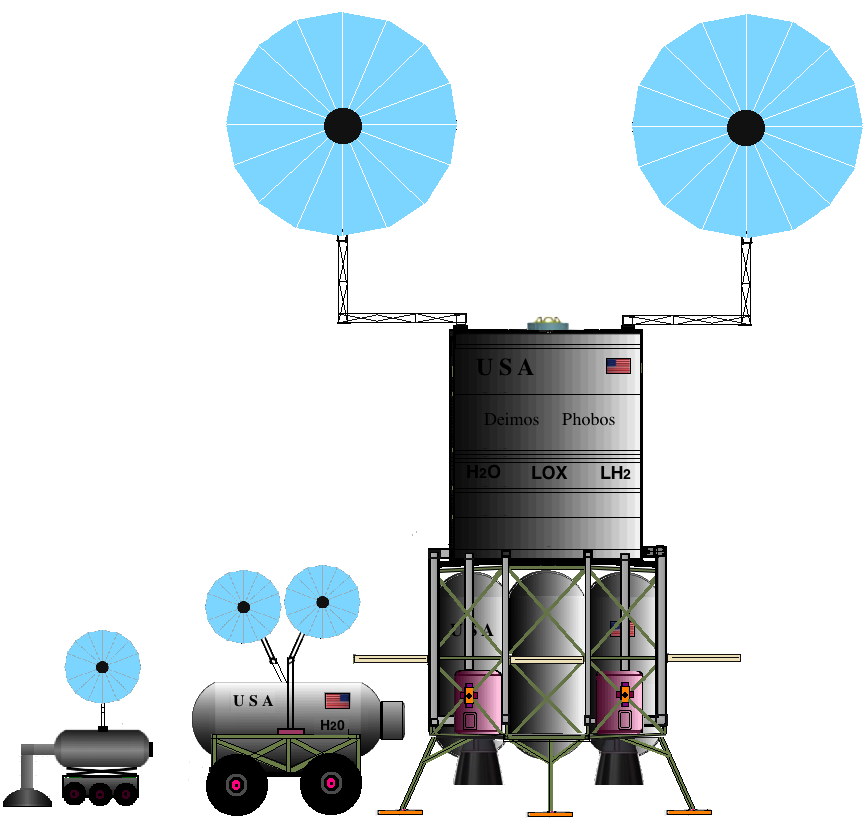 |
| Tethered beneath a hydrogen inflated ballute, a crewed Ares 2 (Ares ETLV-2) reusable landing shuttle slowly descends towards the martian surface. |
by Marcel Williams
Launching human crews from the surface of the Earth to low Earth orbit (LEO) requires a delta-v of more than 9.3 kilometers per second (km/s). But on the Moon and Mars, the delta-v requirements are significantly lower. Launching humans from the surface of the Moon to lunar orbit can require as little delta-v as 1.87 km/s. And launching human crews from the surface of Mars to low Mars orbit requires a delta-v of only 4.4 km/s.
Landing humans on the surface of the Earth and on the Moon is relatively easy. Only minuscule amounts of delta-v are required to for crews to leave Earth orbit and glide or parachute through the Earth's thick atmosphere to the terrestrial surface. The delta-v required to land a crew on the surface of the Moon from lunar orbit is equivalent to the delta-v required to leave the lunar surface to low lunar orbit.
Unfortunately, landing crews and large payloads on the surface of Mars is much more problematical. The largest spacecraft that NASA has managed to safely deploy to the Martian surface are all below 600 kilograms in mass. The weight of a lunar derived crewed vehicle to the Martian surface is likely to weigh as much as 10 tonnes, not including the substantial amounts of fuel needed to return to orbit around the Red Planet. And NASA eventually wants the ability to deploy as much as 100 tonnes of payload onto the martian surface by a single spacecraft.
 |
| Notional ballutes designed to aerobrake into a planetary orbit or to land on the surface of Mars (Credit: NASA) |
The problem with landing large masses on the surface of Mars is that even though the martian atmosphere is approximately 1% as dense as the Earth's atmosphere, it's still thick enough to produce substantial amounts of frictional heating as a vehicle plunges at hypersonic speeds through its atmosphere but still not enough friction to sufficiently lower the terminal velocity as it approaches the planet's surface. Small vehicles (less than 600 kg) attempting to land on Mars have, therefore, been designed to have a high drag coefficients. Designing a spacecraft with a high drag coefficient for vehicles weighing several tonnes or more, however, is much more difficult.
This has pushed NASA towards the idea of utilizing large inflatable ballutes to assist heavy payloads and spacecraft entering the martian atmosphere. The large drag coefficient of a toroidal ballute could allow a spacecraft to decelerate at very low densities high in the martian atmosphere with relatively low rates of frictional heating. The low frictional heat experienced by the ballute could allow for light-weight construction techniques that could enhance the ability to deploy more mass to the martian surface. Ballutes inflated with gases that are lighter than the carbon dioxide could also increases static lift. Recent studies suggest that a toroidal ballute with a tube radius of 80 meters could be used to deliver masses the martian surface of approximately 100 tonnes.
A ballute capable of deploying nearly 40 tonnes to the martian surface
could also easily deploy habitats and cargo larger than those
contemplated for the Altair vehicle to the lunar surface. Cargo missions to the martian surface could utilize ballutes to deploy
mobile robots for excavating and sintering the surface of Mars to
create landing and launch pads for crewed shuttle vehicles and for
regolith shielded outpost similar to those that could be utilized on the
lunar surface.
 |
| Hydrogen inflated ballute would enable the crewed Ares 2 vehicle to aerobrake and land on the martian surface. |
Water factories than mine water from the martian regolith would also need to be deployed. Mobile microwave robots could be used to melt the ice contained in the martian regolith. Water, of course, is essential for drinking, washing, and growing food but is also essential for the production of oxygen for air. Hydrogen and oxygen can also be used to produce hydrogen and oxygen to fuel the reusable shuttle craft.
 |
| Ares 2 hovers near the sintered landing area of a martian outpost. |
Under the scenario presented here, fuel depots and rotational human
outpost would already be placed in high Mars orbit a few years before the first crewed missions to the martian surface along with water and fuel
producing facilities on the surface of the martian moons, Deimos and
Phobos. Human interplanetary missions to Mars orbit would utilize an
orbital transfer vehicle operating between the Earth-Moon Lagrange
points and high Mars orbit.
Such an interplanetary orbital transfer vehicle would utilize fuel manufactured from water exported from the lunar poles when going to high Mars orbit and fuel manufactured from water from the martian moons when returning to cis-lunar space. Such crewed missions would already transport reusable Ares ETLV-2 vehicles to Mars orbit for docking with orbiting space habitats or transferring crews to the surface of the moons of Mars. A single SLS launch could deploy one or two compacted ballutes plus heat shields to high Mars orbit for one or two human missions to the martian surface.
 |
| Rotating regolith shielded (enriched with iron ore) SLS fuel tank derived artificial gravity habitat in high Mars orbit capable of housing as many as 16 astronauts. |
Such an interplanetary orbital transfer vehicle would utilize fuel manufactured from water exported from the lunar poles when going to high Mars orbit and fuel manufactured from water from the martian moons when returning to cis-lunar space. Such crewed missions would already transport reusable Ares ETLV-2 vehicles to Mars orbit for docking with orbiting space habitats or transferring crews to the surface of the moons of Mars. A single SLS launch could deploy one or two compacted ballutes plus heat shields to high Mars orbit for one or two human missions to the martian surface.
 |
| Ares 2 (Ares ETLV-2) about to be fueled for take-off by a mobile LH2/LOX cryotanker. |
Links and References
The Mars Landing Approach: Getting Large Payloads to the Surface of the Red Planet
DUAL-USE BALLUTE-BASED ROBUST AEROCAPTURE, EDL, AND SURFACE EXPLORATION ARCHITECTURE FOR MARS.
Summary of Ultralightweight Ballute Technology Advances
A Survey of Ballute Technology for Aerocapture
TRAJECTORY AND AEROTHERMODYNAMIC ANALYSIS OF TOWED-BALLUTE AEROCAPTURE USING DIRECT SIMULATION MONTE CARLO
An Evaluation of Ballute Entry Systems for Lunar Return Missions
THEORETICAL OBSERVATIONS OF THE ICE FILLED CRATERS ON MARTIAN MOON DEIMOS
SLS Fuel Tank Derived Artificial Gravity Habitats, Interplanetary Vehicles, & Fuel Depots
Pioneering and Commercial Advantages of Permanent Outpost on the Moon and Mars
Utilizing the SLS to Build a Cis-Lunar Highway




















No comments:
Post a Comment